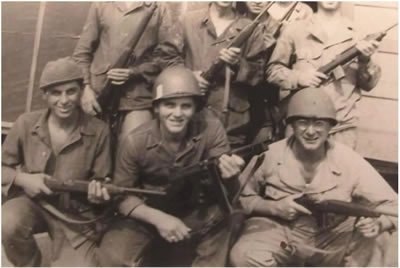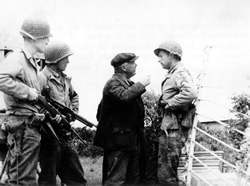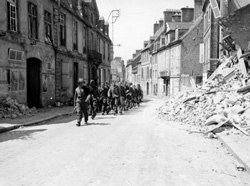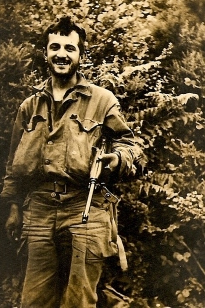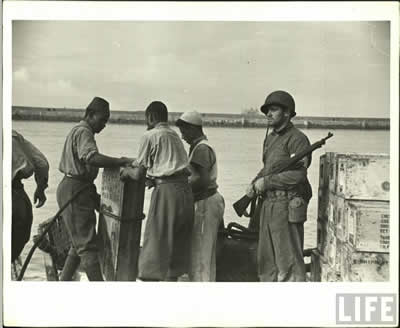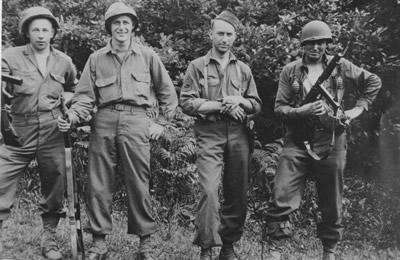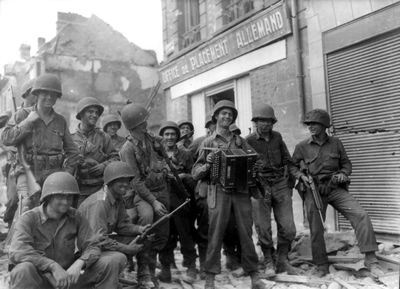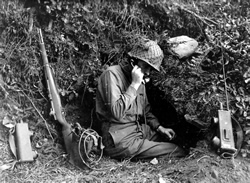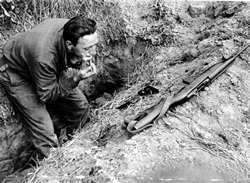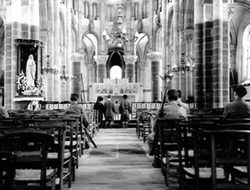WWII G.I. Weapon Carrying Methods
Published: August 30, 2010
Author & Researcher: Charles McFarlane
Contributor & Editor: Mike Ellis
Section III: Soldiers at Rest
While at rest in a combat zone, Soldiers used a blend of techniques to hold their weapons. Some Soldiers continued to use garrison holds, those muscle memory techniques that had been instilled in to them over time. Others, moments out of combat or just lax in discipline, handled rifles in a less serious manner. Rather than re-describe what is written above, I’ll cut to the chase and lay it all out.
Full Port ArmsThe classic parade ground “full port arms”.
The three Soldiers in the back row stand at full port arms, right out of a training film. Likely all carry unloaded weapons – would you feel comfortable being the man with the Thompson, if the man to your right had live rounds?
GIs take a picture for LIFE magazine with German prisoners. While their weapons may be loaded, they are not overly concerned with escape attempts. The man with the carbine lackadaisically eyes the cameraman, likely carrying the weapon low across his hips.
A group of four eyeball discuss the local terrain – three of them are at “full port arms”.
Low Port Arms
GIs keep watch across the road, while two others converse by the jeep. Given the exposed position they are in, it’s unlikely anyone is expecting fire, but they are holding the rifles low for comfort.
Cradled
A GI escorts a company-sized group of German prisoners. While he may be tasked to “guard” them, this group offers little resistance and the GI lazily holds his carbine at his side with one arm.
Reverse Cradled
Another stereotypical technique of wartime GIs, the rifle is rested across one arm, this time pointed skyward. Obviously this man is in no danger, and comfort is his main concern.
Easy Order Arms
The middle Soldier strikes a purely garrison pose, likely with an unloaded rifle.
Slung
In safe areas weapons were commonly seen slung, and for once it appears that reenactors are dead on the mark in doing so themselves.
GIs celebrate liberating a French village. Weapons are slung, though one man does cradle carbine.
The man in the back – one in the four man group has his M1 slung.
Laid on the Ground
This is one of the largest differences in the 1940s military and today’s. Any modern Soldier will wince at the thought of laying a rifle in the mud, yet there are some images showing this being done. Again, these were draftee Soldiers, and the weapons in question are not M16s. Still, when given the opportunity, most Soldiers seem to have preferred leaning the weapon up against something else so it would stay clean.
In most non-combat situations GIs tend to hold the weapon at a form of “full parade rest”, “easy order arms”, or whatever else was comfortable at the time. While the impression given off by some is that the weapon is a clunky weight, others obviously show great care in handling. In any case, GIs viewed their weapons as an important part of their being. These men did everything with their rifle; they ate and slept with it, and they lived or died by it. Possibly because of this shared closeness, many were quite casual in handling. For today’s reenactor who may only handle a weapon every few months the challenge lies in striking a healthy balance between safety and historical authenticity; along with proper muzzle awareness, the above images should help in this process greatly.
Just how close were GIs with their weapons? You be the judge.
I hope this article helps you to better understand how the wartime GI carried his best friend, the rifle. Like you, over the course of this research I discovered many aspects I had previously overlooked and gained a deeper understanding on an outwardly mundane topic. I hope this article has helped you notice more details in original images as well. Above all please remember; despite what the miniseries shows, anything is better than the “low ready”!
Sources:
Life Photo archive hosted by Google
Photos Normandie Archive
NARA - National Archives and Records Administration
Authors Personal collection
Section I: How They Were Taught. These images cover citizen Soldiers in training, some holding a rifle for the first time, some not.
Section II: Theatre Maneuvering and Combat Situations. This is a look at GIs in a tactical setting, where combat experience required new methods.
Section III: Non Combat. This is the most relevant for reenactors, with group shots and posed pictures showing GIs in relaxed situations.
90th IDPG Articles




